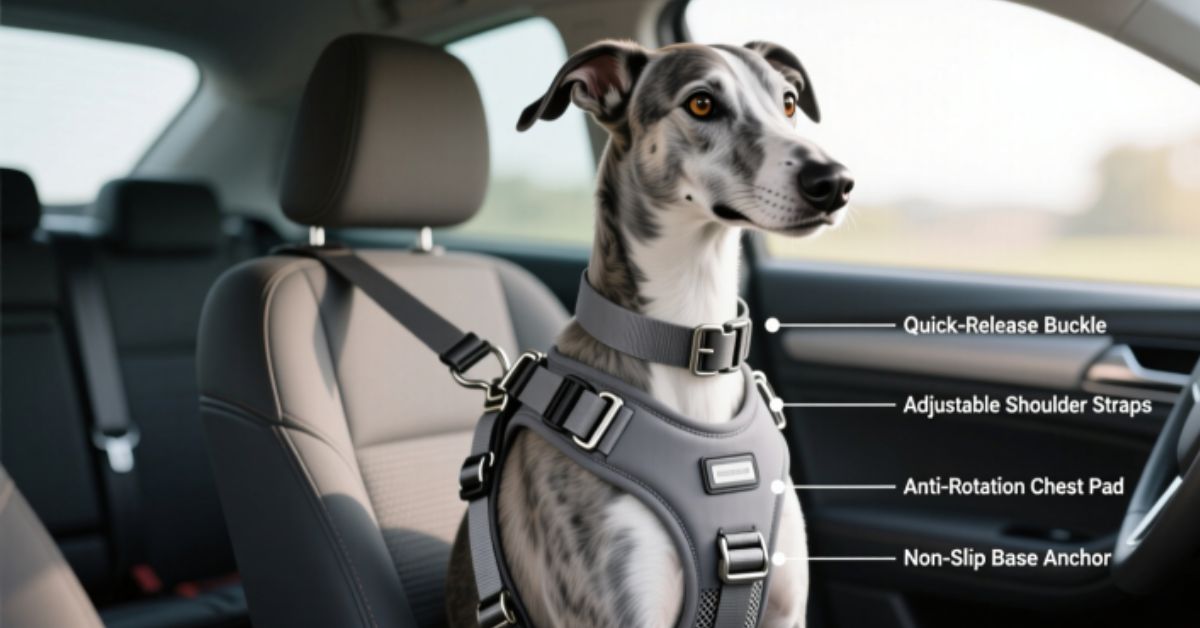Watching your elegant greyhound gracefully bound across a dog park is pure joy. But when it comes to car travel, that same athletic build presents unique safety challenges. A proper greyhound car safety harness isn’t just a nice-to-have accessory—it’s essential protection for your gentle giant’s life.
Unlike other dog breeds, greyhounds have distinctive physical characteristics that make standard car restraints inadequate. Their deep chests, narrow waists, and delicate skin require specialized consideration when choosing safety equipment.
Why Greyhounds Need Special Car Safety Equipment
Greyhounds possess a unique body structure that sets them apart from other dog breeds. Their sighthound build features a deep chest cavity, extremely thin skin, and minimal body fat. These characteristics make them particularly vulnerable during sudden stops or accidents.
Standard dog harnesses often fail to distribute force properly across a greyhound’s body. The typical chest strap can cause injury to their prominent sternum, while poorly fitted equipment can slip off their narrow heads entirely.
Research from the Center for Pet Safety shows that unrestrained pets become dangerous projectiles during crashes. A 60-pound greyhound traveling at just 35 mph generates over 2,700 pounds of force in a collision—enough to injure both the dog and human passengers.
Essential Features of an Effective Greyhound Car Safety Harness
When evaluating options for your greyhound car safety harness, several key features ensure maximum protection and comfort. The harness must distribute crash forces across the strongest parts of your dog’s body while avoiding pressure on vulnerable areas.
Crash-Tested Construction
Look for harnesses that have undergone rigorous crash testing with actual force measurements. The Center for Pet Safety and similar organizations provide independent testing results that reveal which products truly protect during impacts.
Quality crash-tested harnesses feature reinforced stitching, strength-rated hardware, and materials designed to withstand significant force without failure.
Proper Weight Ratings
Most greyhounds weigh between 50-80 pounds, but their lean build can fool manufacturers’ sizing charts. Always check weight limits and choose harnesses rated well above your dog’s actual weight for added safety margin.
Sighthound-Specific Design Elements
The best greyhound car safety harness options account for breed-specific anatomy:
- Wide chest plates that distribute pressure across the ribcage
- Adjustable neck openings that accommodate their narrow heads
- Padded contact points to protect thin skin
- Deep chest accommodation for their unique torso shape
Sizing Your Greyhound for Maximum Safety
Proper fit transforms a good harness into life-saving equipment. Measure your greyhound carefully, as their unique proportions often don’t match standard sizing charts.
Key Measurements for Greyhounds
| Measurement Area | How to Measure | Typical Range |
| Chest Circumference | Around the widest part of ribcage | 26-32 inches |
| Neck Circumference | Just below the collar area | 14-18 inches |
| Body Length | From base of neck to base of tail | 24-30 inches |
| Weight Range | Adult greyhounds | 50-80 pounds |
Take measurements with your dog standing naturally. The chest measurement should be taken at the widest point behind the front legs, not at the narrowest part of the waist.
Fit Testing Your Harness
Once you’ve selected a greyhound car safety harness, perform these fit tests before your first trip:
- Snugness Check: You should be able to fit two fingers under any strap
- Slip Test: The harness shouldn’t slide around when your dog moves
- Comfort Assessment: Watch for any signs of chafing or pressure points
- Range of Motion: Your greyhound should be able to sit, stand, and lie down comfortably
Top Recommended Brands and Models
Several manufacturers have developed excellent options specifically suited for sighthound breeds. These companies understand the unique requirements of greyhound anatomy and have designed accordingly.
Crash-Tested Options
Kurgo Enhanced Strength Tru-Fit offers excellent protection for greyhounds up to 75 pounds. Its steel hardware and padded chest plate make it ideal for the breed’s specific needs.
Ruffwear Load Up Harness provides universal seatbelt compatibility with strength-rated components. The adjustable fit works well with greyhound proportions.
Champion Canine Seat Belt Harness specializes in larger breeds and offers custom sizing options for perfect fits.
Installation and Daily Use Tips
Proper installation ensures your greyhound car safety harness functions as designed. Most quality harnesses attach to your vehicle’s existing seatbelt system without requiring additional hardware.
The harness should position your greyhound in a natural sitting or lying position. Never allow slack that permits your dog to reach the front seats or windows during travel.
Regular inspection prevents equipment failure. Check stitching, hardware, and webbing for signs of wear before each trip. Replace any harness showing damage immediately.
Beyond Basic Safety: Comfort Considerations
Long trips require additional comfort measures beyond basic restraint. Greyhounds can become anxious in confined spaces, making proper conditioning essential for stress-free travel.
Introduce the harness gradually at home before attempting car trips. Allow your greyhound to wear it during short periods while receiving treats and praise.
Consider temperature regulation during travel. Greyhounds have minimal body fat and can become cold quickly in air-conditioned vehicles. Bring blankets or cooling mats depending on weather conditions.
Training Your Greyhound for Car Travel
Successful car travel begins with proper training and conditioning. Start with brief sessions in your parked car, gradually increasing duration as your greyhound becomes comfortable with the restraint system.
Reward calm behavior with treats and praise. Many greyhounds initially resist harness wearing, but patience and positive reinforcement overcome this resistance.
Practice emergency stops in safe environments. This helps both you and your greyhound understand how the safety system functions during sudden deceleration.
Conclusion
Investing in a proper greyhound car safety harness protects your beloved companion while ensuring legal compliance in many jurisdictions. The unique anatomy of greyhounds demands specialized equipment that standard dog restraints cannot provide.
Take time to research, measure carefully, and choose quality over price. Your greyhound’s safety depends on making informed decisions about car travel equipment. Start shopping today and transform every car ride into a secure, comfortable experience for your gentle giant.
Frequently Asked Questions
Q: Can I use a regular dog car harness for my greyhound?
A: No, greyhounds need specialized harnesses designed for their unique sighthound anatomy and thin skin.
Q: How often should I replace my greyhound’s car safety harness?
A: Replace immediately if damaged, or every 3-5 years for regularly used harnesses showing wear.
Q: Is it legal to have an unrestrained dog in the car?
A: Laws vary by state, but many jurisdictions require pet restraints and impose fines for violations.
Q: Can my greyhound wear the harness for walking too?
A: Some models work for both, but specialized walking harnesses often provide better comfort for daily use.
Q: What if my greyhound gets carsick with the harness?
A: Gradual conditioning and ensuring proper ventilation usually resolves motion sensitivity issues.












